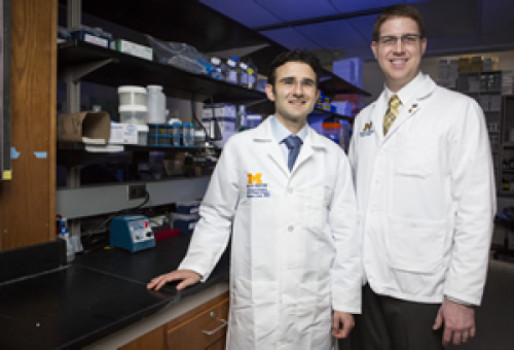
An anti-inflammatory treatment, studied in the labs of regenerative medicine specialists and trauma surgeons, may prevent what’s become one of the war-defining injuries for today’s troops.
Those burned by high-velocity explosive devices are at-risk for heterotopic ossification (HO), in which bone develops in places it shouldn’t be, outside the skeleton, in joints, muscles and tendons. The painful condition can make it difficult to move and function and commonly affects patients who suffer burns, automobile accidents, orthopedic surgery and blast injuries and other combat wounds.
Research led by the University of Michigan Health System sheds light on how and why HO develops and reveals a potential method to interrupt the cell signaling that leads to abnormal bone growth.
Using tissue from burn patients and a mouse model of trauma-induced HO, researchers analyzed the body’s response to burn injury. They confirmed the link between burn injury and activity of ATP, a primary energy source for cells that, when elevated, can make reactions normally impossible in biological conditions, possible — such as ectopic, or abnormal, bone.
By using an apyrase, a compound capable of breaking down ATP, researchers were able to reduce heterotopic ossification, according to study findings published in Science Translational Medicine.
Additional study will be required to develop an HO prevention therapy for humans that can be tested for safety and effectiveness.
“These findings are exciting and suggest that localized anti-inflammatory treatment may help prevent future development of ectopic bone, even at sites distant from the trauma,” says lead study author Benjamin Levi, M.D., a plastic and reconstructive surgeon at the University of Michigan.
He is director of the Burn/Wound and Regenerative Medicine Laboratory at the University of Michigan where research teams are focused on prevention and early diagnosis of HO before it’s visible on x-rays and CT scans.
Levi, along with lead author Jonathan R. Peterson, of the University of Michigan Medical School, and Stewart Wang, M.D., Ph.D., Director of Burn Surgery at the U-M Health System, worked with colleagues from the Naval Medical Research Center, the University of Texas Medical Branch, Massachusetts General Hospital, and surgery, public health, chemistry, bioengineering and dental faculty at the U-M on the current study.
Apyrase treatment beyond burns
In addition to burn and trauma patients who are at risk for HO, more than one million patients a year undergo joint replacement in the United States and 20 percent of these patients will develop HO.
Authors of an accompanying editorial, “Burned to the Bone,” suggest study of an apyrase treatment for heterotopic ossification formation go beyond high-risk burn patients.
The debilitating bone condition has complicated more than 60 percent of severe wartime orthopedic casualties during the Afghanistan and Iraqi conflicts, impacting more than 1,200 veterans, editorial authors note.
Additional study, they say, may reveal whether the treatment would help those suffering traumatic brain, orthopedic and spinal cord injuries.
Story Source:
The above story is based on materials provided by University of Michigan Health System. Note: Materials may be edited for content and length.
Journal Reference:
- J. R. Peterson, S. De La Rosa, O. Eboda, K. E. Cilwa, S. Agarwal, S. R. Buchman, P. S. Cederna, C. Xi, M. D. Morris, D. N. Herndon, W. Xiao, R. G. Tompkins, P. H. Krebsbach, S. C. Wang, B. Levi. Treatment of heterotopic ossification through remote ATP hydrolysis. Science Translational Medicine, 2014; 6 (255): 255ra132 DOI: 10.1126/scitranslmed.3008810
